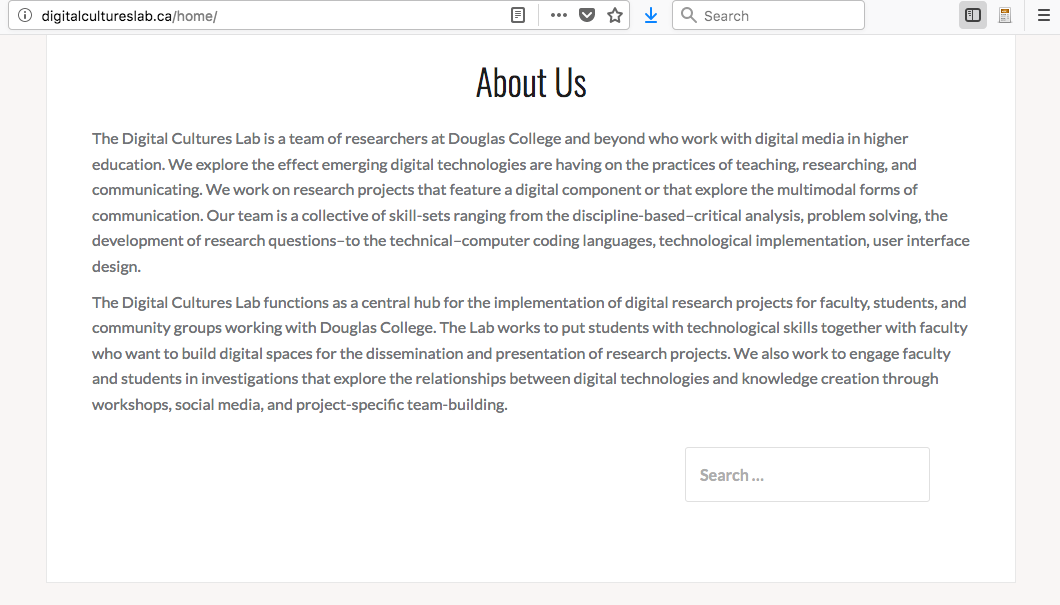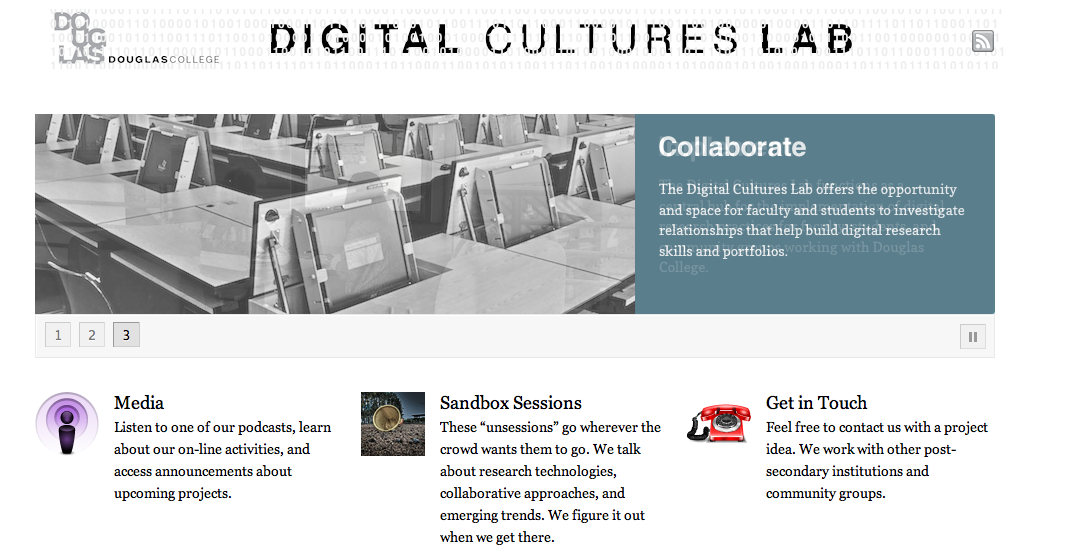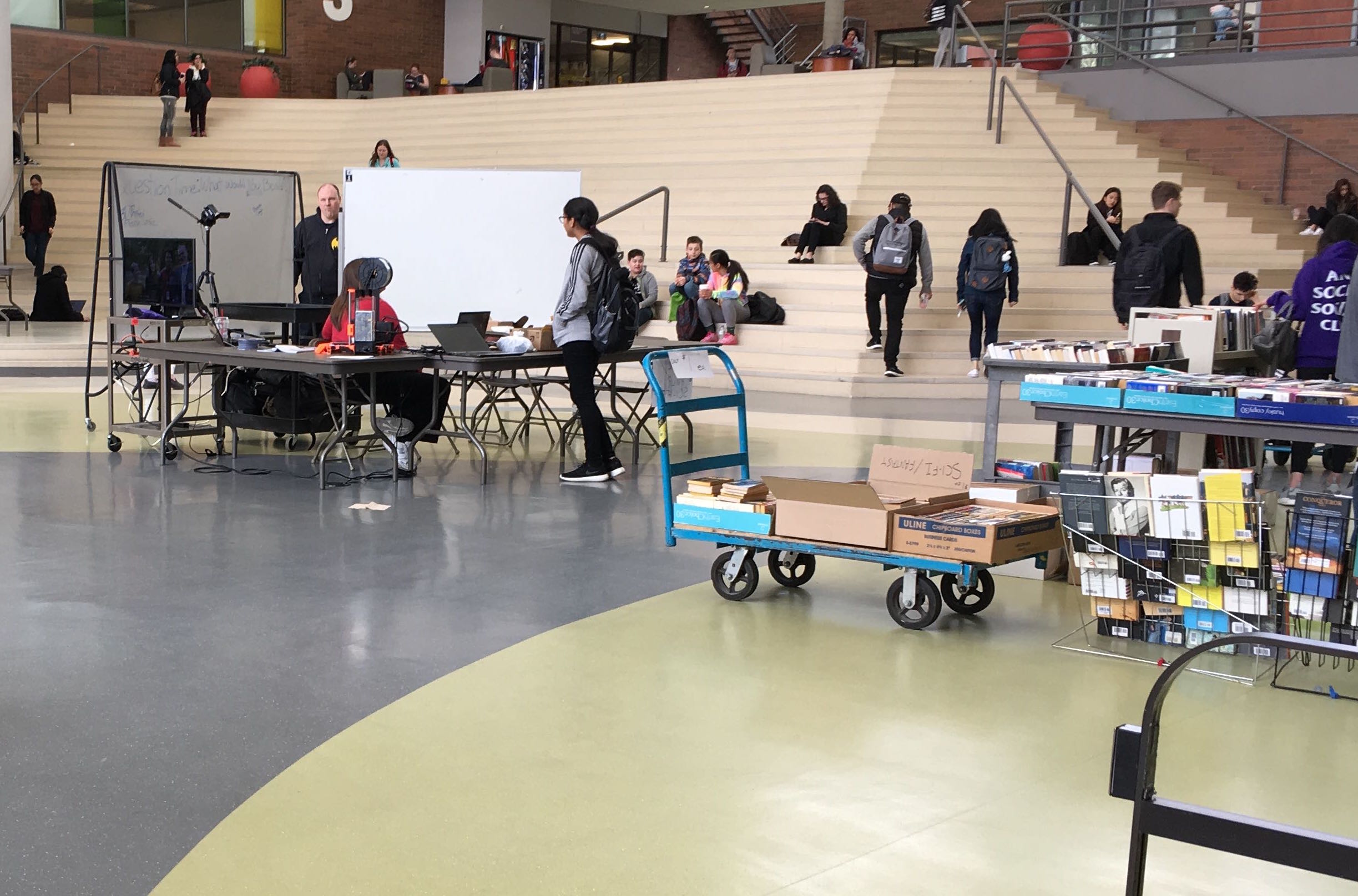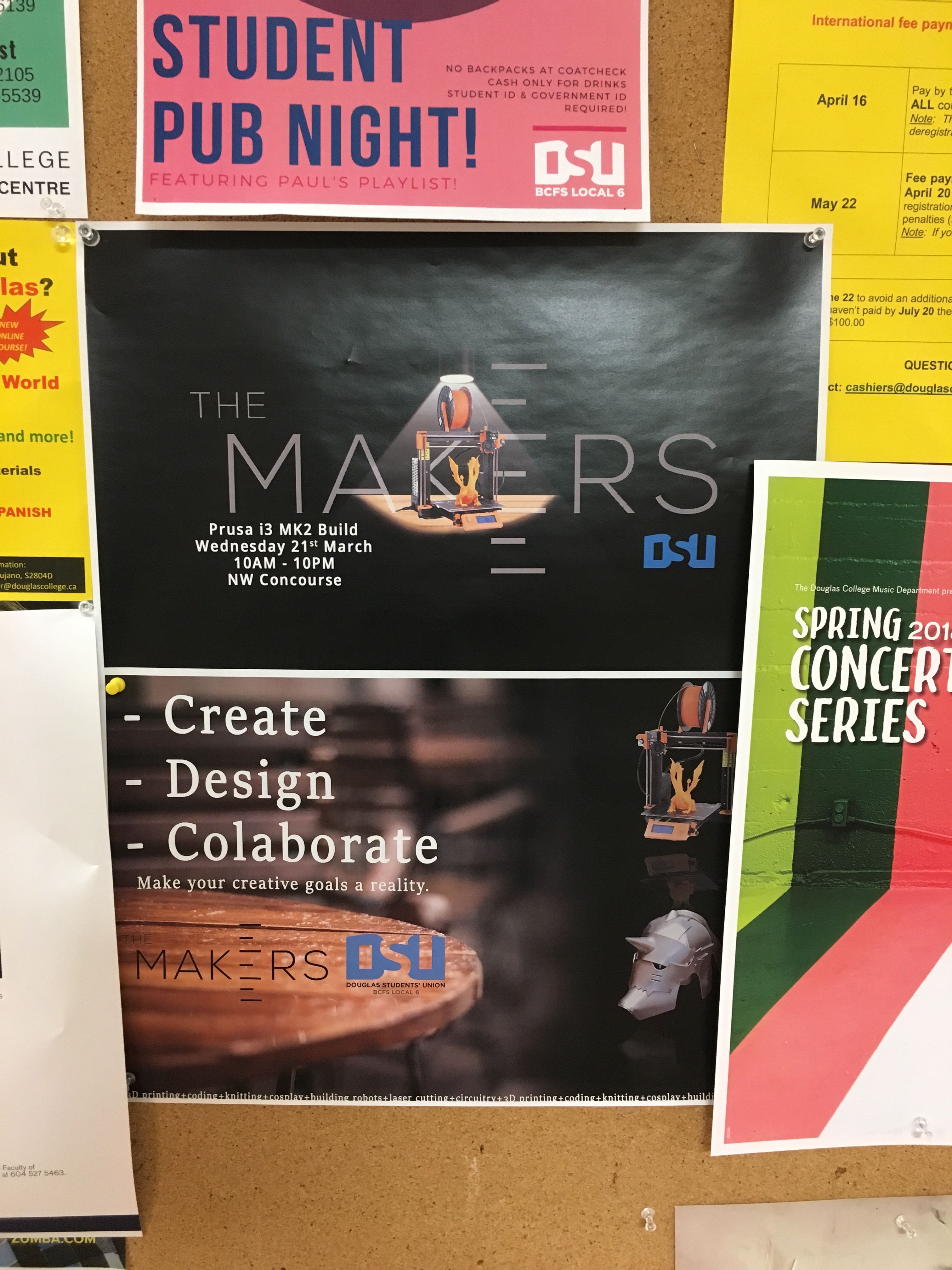This post sums up the activities of the last five years of The Digital Cultures Lab, chronicling how The Lab shifted and changed its mandates over time and hopefully getting at the core of what creating The Lab, and keeping it going, achieved. Briefly, The Digital Cultures Lab was both an etherial and physical space, or “presence,” that encouraged engagement with emerging trends in humanities practice–mostly teaching, but some research. I note etherial and physical because The Lab started as a collective of individuals (well, mostly me and a few research students), and then expanded to take on a physical space with a more hackerspace vibe–I explain all this below. The word “presence” takes the place of “space” or “group” or “hakerspace” or “incubator” or “pedagogical collective” because The Lab was all those things and something else; the word “presence” captures the arbitrary, but tangible nature of The Lab’s existence. The term “presence” also signals the kind of lingering aura of lab spaces such as these in humanities practice–they are not so much a place as they are a presence, utilized in any number of ways; sometimes malleable, sometimes immutable.
If you want to skip to a more “listy” thing, go and check out the inventory of accomplishments and projects. If you’re looking for the original “What it Takes to Start a Makerspace” post I wrote about what things looked like after a year, you can find that here.
Let me begin at the end: we ran out of funding and I ran out of energy. If you want to start any group-based incubator for anything, you’ll need lots and lots of energy and a little bit of funding. I suppose I should qualify that by noting that you’ll need energy to:
- Broker and establish relationships between individuals and their skill-sets
- Interview, coordinate, and direct student research assistants
- Manage the upkeep of equipment and consumable stuff that you’re burning through–both literally burning and figuratively burning in the case of The Lab
- Constantly respond to requests for clarification, tasks you might perform, and clarifications about your need / purpose / or desire to exist
I cannot believe that The Lab lasted five years. While the legacy of The Lab is one that will no doubt start to fade pretty quickly, there’s no doubt that I got a lot out of my participation in the endeavour and that some others got something out of it too.
So that’s the quick and dirty, the rest of the story is as follows:
What I Learned:
Full disclosure, I never really thought of the Digital Cultures Lab as a real thing. It was always something that was a front for stuff I was interested in; a kind of nickname that gave me the cachet and power of a group or team, but ultimately without the group or team. Thinking of how a “Lab” might function allowed me to think big, to think about impact and scale beyond a personal scope, to think into the future about what something could become. But, I would be lying if I said running an actual lab was the intention. The only real intention I had when I set out was to do some interesting work, and to make sure that students were involved in that work–directly.
The idea initially was born out of examples that began to proliferate in the early 2010s, just as I was getting my legs in a “real job” at a post-secondary institution where I had some leverage and a desire to establish something for myself. I was inspired by the examples such as the Electronic Textual Cultures Lab, The Maker Lab in the Humanities, and learning collective such as DHSI and INKE. I was fortunate to be nested on the West Coast where it seemed to me that all these collectives were emerging at the same time, mostly out of the University of Victoria, an institution with the prescience to be on the tip of the wave when it came to the emerging field of the Digital Humanities.
At the same time, there were lots of other examples that piqued my interest and served as a model for what I wanted to do: ADHO(The Alliance of Digital Humanities Organizations), CSDH/SCHN (The Canadian Society of Digital Humanities/Société canadienne des humanités numériques), EMiC(Editing Modernism in Canada), MVP(The Modernist Versions Project), NINES(The Networked Infrastructure for Nineteenth-Century Electronic Scholarship), SHARP(The Society for the History of Authorship, Reading and Publishing), MITH(Maryland Institute for Technology in the Humanities). All of these organizations fell into orbit around my newly-established professional world, it seemed, all at once and I needed to do something to keep up with these Joneses, something of my own to launch into orbit.
It’s important to note the surge in Collectives (capital intentional) such as those above around 2010-11. There seemed to be a newly launched tool or research Collective coming out every week; THATCamps were everywhere, “One Week; One Tool” changed how academics modelled working together. HASTAC was almost ten years old. It was a fertile time, marked by the “big bang” of the Digital Humanities emerging as a legitimate discipline. The Collectives I mention above are just a few of the examples were probably all going concerns before, but they emerged in 2010. Perhaps the most important thing that happened, and what facilitated the emergence of the Collectives, was the uptake of Twitter as a legitimate channel for academics and academic discussion. Twitter made the world feel really small and for what felt like the first time, academics were talking to each other and sharing in a way that just wasn’t as open and visible as it had been–ideas, models, people, were introducing themselves all over the place. So, in this climate of production, boasting, collecting, and generally doing, I decided I needed something, cue: The Digital Cultures Lab.
I think it’s probably relevant to note that I was already part of a Collective at this point: Graphixia. Graphixia is a collective of comics scholars founded by myself and Peter Wilkins when we started blogging about comics in 2009. But, I wanted to do other things with my digital skills that I couldn’t do as part of Graphixia and there was no reason I couldn’t do both–and I have. The point of this little aside is to say that I had a sense of what it would look like and be like to work as part of a collective. I knew the energy required to make it work even a little bit. However, The Digital Cultures Lab was really just me, despite what the “About Us” page might have said. There was no “team” and it wasn’t a “central hub.” But dammit, one day it would be; I had convinced myself and, I had a twitter handle. By-the-way, that Twitter handle is by far the best archive we have–what a trip going through all that history.

What I Started:
I started The Digital Cultures Lab by purchasing the “.ca” domain name and getting a website up. This move was one of the most important things I learned during the uptick in academic collectives–having a website made you legitimate. The website was an easy way to make things look real, established, viable, when things were really just me sitting at a desk wondering what I could do as “The Digital Cultures Lab” and in need of people I didn’t want to ask to help me with that wondering. The website allowed me to point people, both outside my institutional locus and inside the institution, to a place where there was information, an exaggerated bio page, a list of projects (that I was already doing without a lab); like I said: it gave legitimacy to the fledgling.

Now, here’s the next little aside. Pretending that The Lab was an ongoing entity was a batshit truckload of work. Next time, I might move more quickly into making it a real thing, however meagrely it might exist; because when you get things such as institutional sanction, a tangible space instead of a virtual or online space, a real group of people, a project plan, you are accountable to something tangible, rather than something that is never quite real. Because The Lab existed in a kind of etherial space (I note in hindsight), it was never real enough for honest assessment. In other words, one did not have to ask if The Lab was worth other people’s time, whether there was a need for it within the institution, whether it justified the space it took up, or how others might be involved and what they might do. What I realize now is that I was guilty of creating an entity that I wanted to exist, not one that needed to exist. The effort required to keep an entity alive based on my desires is way stronger than the effort required to support something that is actually needed–clearly, without my momentum, The Lab wasn’t going anywhere.
What I also realize now is that one of the things holding me back from seeking the tangible markers for legitimacy and existence noted above was embarrassment. I was too tentative and insecure about what I was doing–another sign what I was doing probably shouldn’t exist–to make it real and I sure as hell did not want to take real responsibility for its existence. Sure, there’s no doubt that what I am speaking to here is what we call “imposter syndrome,” but my refusal to admit that The Lab was an actual thing hurt my ability to ask others to join, to apply for the requisite funding for legitimacy. In short, my own inhibitions are what allowed The Lab to survive for so long–I was never on the hook for anything, so I could pivot on the head of pin. At the same time, these same inhibitions were, in the end, the reason for its closure. When you are working on things few people have a real grasp of, you always run the risk of being unable to explain what it is you do–you frequently have to ignore or confront the “side-eye,” real or implied, that suggests what you are doing is ridiculous, unnecessary, or bald favouritism by some unseen entity.
In the end, what I have been calling the etherial nature of the Lab’s definitions means that I am happy to be able to get out from under The Lab and its quasi commitments with relative ease; it didn’t take much to get everything into boxes and tell a few people that I’d had enough. That said, The Lab’s legacy (and that of the work I did keeping it afloat as a quasi-entity) is fractured across several places, difficult to determine, and in some cases, totally invisible. It’s like it never existed at all; and that can be a hard thing to accept when you’ve put energy into something, even if you know now it was doomed from the start. It’s enough to illustrate this by saying that The Lab–and a lot of what went on when it was a thing–is now in the proverbial “Lost Ark” storage building.
Students:
Getting back to the linear narrative, things started to pick up speed pretty quickly once that website was up and I was rolling around changing business cards and applying for funding. Given that I work in a relatively small Community College, I did not have the resources–institutional space, faculty expertise, student expertise (or energy)–to really pull in funding envelopes that would be needed to make The Lab an “ongoing concern.” However, I was able to scrape together some funding, mostly from private companies, to hire student research assistants. A small company agreed to front the money for a student research assistant (we paid them about $2500 a semester at the time) on the condition that they get named in the funding and that they get first crack at the student for hiring purposes once they finished working in The Lab. There were also a few internal funding mechanisms at the College and I tapped those as well for student research assistant funding.
In bringing students aboard, I was simply repackaging my own research (that I now had students helping me with) as activities of The Lab. It worked well, and looking back, I really should have kept things there; without engaging a physical infrastructure. Being part of a “Lab,” gave students immediate reward in membership and also in terms of getting automatic credit for the work they were doing. They were part of a collective and while I could certainly single them out if any results came from the research, even if I didn’t they were always part of The Lab and contributing to it; that was automatic. Their labour was never hidden because they were always members of The Lab that produced the work.
There were no big government-backed grants coming though. And, the infrastructure and project commitments needed for larger funding models collided headlong with my four courses a semester teaching load. There simply wasn’t enough time, structural or human support–students in my College are mostly 1st-year commuters and do not possess specialized skills in my area–no English Majors and there’s no space in the College for them to “nest” and do work. Everything worked for awhile, but I was alone in the desert doing the work–there was not a lot of uptake–and the students, through no fault of their own, did not have the skills they needed to undertake the tasks I was giving them with efficiency. The students, given the transfer nature of the institution, were also incredibly transient, meaning that they never hung around long enough to really understand what they were doing.
The above shouldn’t suggest that the research assistants did bad work. I just didn’t know how to help them do what I needed them to do and encourage them to explore new venues of discovery they might find for themselves. I should also say that, given I work in an access institution without a Major in my field, there was little motivation for students to do anything. And, I would be lying if I didn’t note that I was taken advantage of on more than one occasion. It’s a different world in a university, put it that way. If you work in a university infrastructure, never forget the privilege you have been given that is the opportunity to experience the students you have. Even their commitment to 3-4 years of schooling is insanely valuable.
There’s a Room:
After two years or so, the work I was doing started to get a little attention from administration. I was giving some talks about what I was doing around the College. As well, conversations about the Digital Humanities were starting to creep into the mainstream press and administrative circles of the academy and everyone started pointing at me. While all this was happening, Makerspace culture began to emerge–there’s that word again, lots of emerging!–in cultural conversations as well and I had just embarked on a project that involved fabrication. So, largely bowing to pressure from the institution–in a good way–I was put in charge of establishing a Makerspace at the College. I figured this pivot would be a great way to get The Digital Cultures Lab a space and be a nice addition to activities already underway. I’m not gonna get into all that went on with the Makerspace, but if you are interested, this write up about where we were at a year-and-a-half in is a good narrative of what was the high point of The Lab’s existence.
Needless to say, the Makerspace was an interesting endeavour, but it was too far away from the campus, couldn’t be run properly, and didn’t really have a space within the mandate of the institution. I wrote a lot about Makerspaces as a concept, and I think we did a lot of good work once we moved to the library proper, but things just never took hold in a way that was manageable. I was being pulled in too many different directions and near the end did not feel I had any institutional support–or the justification for any (see the introduction above).
Here is some reading if you want to go down the rabbit hole that was the last year and half after we moved into the College library and I finally found Dixon Cohee, who really made the library space a collaborative venture and continues to work with the Maker Club he established in the College.
ReThinking Failure in The Hackerspace
Getting to the Point.
Persistence and Serendipity: Summer in the Hackerspace.
The Makerspace Classroom: The Classroom as Open Textbook and Ancillary OER Makerspace.
Assessing the Maker Lab: What’s Going on After a Year?.
At some point soon, I’ll put a link here that more properly organizes the above writing, and gets at what The Lab looked like in its final iterations, but the list will have to do for now. One thing I did learn at this late point is the importance of finding the right students to work with. If Dixon had been there at the beginning, I really think the outcome of The Lab would have been quite different. Dixon had skills that complimented mine, he bought into the collaborative nature of the venture, and he was affable. In short, he was the perfect fit. That he came four years into the venture illustrates some of the difficulties getting things off the ground in a tangible way. Find your Dixon as soon as you can and then hold onto them like grim death.
Beginnings are the Ends:
Well, there’s the origin story and the final chapter too, I suppose. All that said, I’m proud of what The Lab managed to achieve. When I look back at the website and the Twitter handle, I think we did a lot of cool stuff and we had some real impact on a few individuals. We got mentioned in the newspaper a few times–there’s even a radio interview out there somewhere. I’m happy The Lab phase of my life is over and I’m even more happy to say that I got a lot out of it. I’m much clearer now about what I want to do and how I want to expend my energies–that in itself is an incredibly valuable takeaway.
Legacies:
As I note above, if you want to delve into things further, there’s a list of all the things we accomplished. Click on that link and go ahead and peruse it if you think it would be helpful or if you’re interested. Below are a few pictures of one of the lasting legacies that I think represents what I speak to above. The student Maker Club that was established while Dixon was working in The Lab went out and got themselves a Prusha 3D printer–this is one that you put together yourself; open-source if you like. And, they held a session in the College concourse to try and drum up other members for the club.

I was thrilled to see that the Maker Club had spun off into something that the students had a stake in and that was done without me. I was a little shaken by the typo in the poster, but it does illustrate the point I was making above about the preparedness of students.

Who hasn’t committed an error of this sort on one of their first forays out into the real world? The point is that the tenets of The Digital Cultures Lab and its subsequent Hacker Space made it out into the real world and motivated students to explore things on their own–nothing to complain about there. It’s legacies such as this that make me feel like the lab was a worthwhile venture.
Share this post:
Licensed under Creative Commons Attribution-NonCommercial-ShareAlike 2.5 Canada